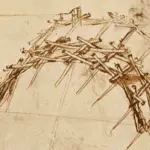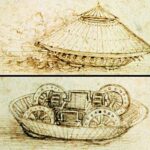
Leonardo da Vinci self-supporting bridge
Leonardo da Vinci self-supporting bridge is a remarkable example of his innovation and engineering skills.
You’ve come to the right place if you’re curious about why da Vinci created this ingenious structure. This article will explore the historical and practical reasons behind this invention, giving you a comprehensive understanding of its significance.
Da Vinci designed the self-supporting bridge to showcase his ability to create practical yet efficient solutions for transportation.
During his time, bridges had to be durable and easy to assemble, especially for military purposes.
The design took a new approach, allowing quick assembly without complex tools or materials. This was ideal for armies needing rapid deployment across obstacles.
Under the patronage of influential leaders like Cesare Borgia, da Vinci had opportunities to demonstrate his engineering prowess.
His self-supporting bridge was a testament to his artistic and scientific talents but also a response to the demands of his era.
By mastering the principles of balance and weight distribution, he revolutionized bridge construction by designing a bridge that effectively used tension and compression.
This simplicity and effectiveness made it a lasting work of engineering genius, as reflected in Leonardo’s self-supporting bridge.
Leonardo da Vinci self-supporting bridge: Historical Context
Leonardo da Vinci’s self-supporting bridge was a groundbreaking feat of engineering during the Renaissance. Remarkable advancements in science and art marked this period, and da Vinci was crucial in pushing these boundaries.
Leonardo da Vinci’s Engineering Marvels
Leonardo da Vinci is well known for his innovative ideas that spanned art, science, and engineering. Among his remarkable concepts was the self-supporting bridge, which required no nails or ropes to hold it together.
This bridge design depended solely on the precise cutting and interlocking of beams. Da Vinci’s revolutionary design demonstrated incredible foresight and understanding of structural integrity.
Da Vinci devised this bridge under the patronage of Cesare Borgia when he was acting as a military engineer. This role allowed him to innovate within the confines of military needs.
The bridge showcased his ability to think beforehand, combining practicality with ingenious simplicity. It also highlighted his ability to transform his theoretical knowledge into practical solutions.
Innovations in Civil Engineering during the Renaissance
The Renaissance was a time of unprecedented European change, impacting science, art, and technology. Civil engineering saw substantial progress as engineers experimented with new materials and construction techniques.
Leonardo’s self-supporting bridge contributed to civil engineering during this era.
This period encouraged the exploration of new ideas and methods. Leonardo da Vinci’s bridge became symbolic of the Renaissance spirit of innovation.
Unlike traditional bridges, it was portable and quick to assemble, ideal for military uses. The concept reflected the Renaissance enthusiasm for engineering solutions that were both functional and aesthetically pleasing.
It remains a remarkable example of da Vinci’s forward-thinking approach to civil engineering.
Design Philosophy
Leonardo da Vinci’s self-supporting bridge reflects his innovative engineering approach, combining principles of structural integrity with simplicity and functionality.
Da Vinci’s Approach to Structural Integrity
Leonardo da Vinci’s efforts integrated principles of stability and balance into his bridge design.
Leonardo da Vinci’s self-supporting bridge maintained its structural integrity by using interlocking beams that supported each other. This approach was revolutionary, considering the materials and construction techniques available in the late 15th century.
Da Vinci emphasized the importance of weight distribution.
Each beam was carefully positioned, creating a bridge that could withstand significant load without collapsing. This innovation highlighted his deep understanding of physics and mechanics, allowing his bridge to remain functional in various conditions.
Simplicity and Functionality in Design
Da Vinci’s self-supporting bridge design prioritized simplicity and ease of assembly.
The components were designed to be assembled quickly, making it ideal for military applications.
Soldiers could rapidly construct or deconstruct the bridge in the field using straightforward Leonardo da Vinci bridge instructions, enhancing mobility.
The lack of nails or binding materials reduced complexity and increased adaptability. This self-supporting bridge design allowed for various implementations depending on immediate needs.
Leonardo’s emphasis on functionality underscored his practical thinking. He ensured the bridge met the demands of the time while showcasing how design could merge simplicity with purpose.
Mechanical Principles
Leonardo da Vinci’s self-supporting bridge showcases innovative engineering techniques, combining tension-compression and interlocking mechanisms to create a stable and efficient structure. These techniques allowed for a durable and easy-to-assemble design.
Principles of Tension and Compression
The self-supporting bridge Leonardo built utilized tension and compression principles effectively.
Tension refers to the forces that pull materials apart, while compression forces push materials together.
By arranging the wooden beams in specific patterns, da Vinci harnessed these forces to create a stable structure without the need for nails or screws.
For instance, when weight is applied to the bridge, the upper beams undergo compression while the lower beams experience tension. This clever use of force allows the bridge to remain firm under load, as with the estimated da Vinci bridge weight limit.
Da Vinci’s understanding of these principles led to a bridge design that could support substantial weight using only wooden beams and withstand various environmental conditions.
This mastery of mechanical forces demonstrated how engineering principles can create self-sustaining structures.
Interlocking Mechanisms
Interlocking mechanisms play a critical role in the self-supporting bridge designed by Leonardo.
The bridge’s beams are arranged to slot into each other, forming a network of interlocking supports. This method eliminates the need for additional fasteners like dowels or nails, simplifies construction, and allows easy assembly and disassembly.
These interlocking connections strengthen when a load is applied, enhancing the structure’s stability.
This design principle reflects da Vinci’s ingenuity and showcases his ability to create functional and aesthetically pleasing structures.
Today, builders can understand how to build the da Vinci bridge using interlocking mechanisms, which mirrors the effectiveness and elegance of Leonardo da Vinci’s original design.
Military Utilization
Leonardo da Vinci’s self-supporting bridge was a remarkable invention with practical applications in military contexts. Its innovative design allowed rapid deployment in warfare scenarios, offering strategic advantages for military forces with its portability and quick assembly.
Rapid Deployment in Warfare
The self-supporting bridge of Leonardo da Vinci was explicitly designed to aid in military operations.
Soldiers could quickly assemble and dismantle it, making it invaluable in crossing rivers or other obstacles during campaigns.
This ability to deploy swiftly gave armies a tactical edge, allowing them to move faster and surprise enemies.
The design required no tools or specific equipment, relying solely on the interlocking of beams. This simplicity ensured that even troops with minimal engineering knowledge could construct it effectively.
The bridge’s self-supporting nature meant it could withstand considerable weight without additional support, helpful in moving troops and equipment quickly.
Advantages of Portability and Quick Assembly
The portable design of the self-supporting bridge da Vinci created was a key advantage in military applications.
Unlike traditional bridges, which require time-consuming construction, this design was easy to transport and set up at different locations without requiring heavy machinery or extensive labor.
The quick assembly process meant the bridge could be deployed within hours, facilitating swift advancements in demanding conditions.
Such efficiency minimized the risks of prolonged exposure to enemy forces during construction. The lightweight materials used ensured ease of transportation, enabling troops to maintain mobility and adaptability on the battlefield.
Cultural and Educational Impact
Leonardo da Vinci’s self-supporting bridge has influenced modern engineering education and the design of future bridges. This design is studied globally as an example of ingenuity and simplicity in problem-solving.
Influence on Modern Engineering Education
Leonardo’s innovative approach to bridge design provides a valuable case study in engineering education.
His self-supporting bridge requires no fasteners or supports, showcasing a minimalist and efficient use of materials.
Engineering students often learn how to build a Leonardo da Vinci bridge to understand structural integrity and balance, relying solely on compression.
Assembling parts that lock into place naturally gives students practical experience in understanding weight distribution and stability. This exercise also teaches the importance of creativity and lateral thinking in engineering, and Leonardo’s legacy is credited with fostering innovation in educational settings.
Da Vinci’s Legacy in Bridge Design
Leonardo’s self-supporting bridge design is an enduring testament to his genius. It influenced architects and engineers in bridge construction.
The da Vinci bridge was groundbreaking and symbolized sustainable design principles.
It offers a simple yet effective solution and requires minimal resources, making it an attractive formula for contemporary sustainable architecture.
Modern adaptations of Leonardo’s original concept have been explored, implementing the idea in varied contexts and scales.
The principles outlined in the Leonardo da Vinci bridge instructions serve as inspiration for eco-friendly and cost-effective designs.
By revisiting these concepts, engineers explore how historical innovations can address modern-day challenges, keeping Leonardo’s inventive spirit alive in today’s bridge design community.
Final Thoughts
Leonardo da Vinci’s self-supporting bridge showcases his genius and understanding of engineering and design. This structure is a testament to human creativity and innovation during the Renaissance period.
His bridge design demonstrated how minimal materials could create a stable and effective crossing.
His self-supporting bridge involves a clever interlocking arrangement of beams. The design requires no complex tools or fasteners.
This simplicity served as an ingenious example of doing more with less.
The project also demonstrated da Vinci’s versatility. It connected engineering with art and science, illustrating his ability to think beyond conventional boundaries.
The self-supporting bridge is a timeless symbol of innovation that remains relevant today.
Modern engineers can gain valuable insights by understanding the core principles behind da Vinci’s invention.
The bridge’s design principles relate to ancient and contemporary ideas about efficiency and sustainability.
A deeper look at da Vinci’s inventions reveals the bridge’s blend of simplicity and functionality.
Self-supporting structures, inspired by da Vinci’s concept, continue to influence modern construction techniques.
Engineers and designers still study his work, finding inspiration in his unorthodox approach and impeccable foresight.
In your exploration of historical engineering, da Vinci’s self-supporting bridge links the past and future of design.
 I’m Leonardo Bianchi, the mind behind Leonardo da Vinci's Inventions. Thanks for visiting.
I’m Leonardo Bianchi, the mind behind Leonardo da Vinci's Inventions. Thanks for visiting. 


